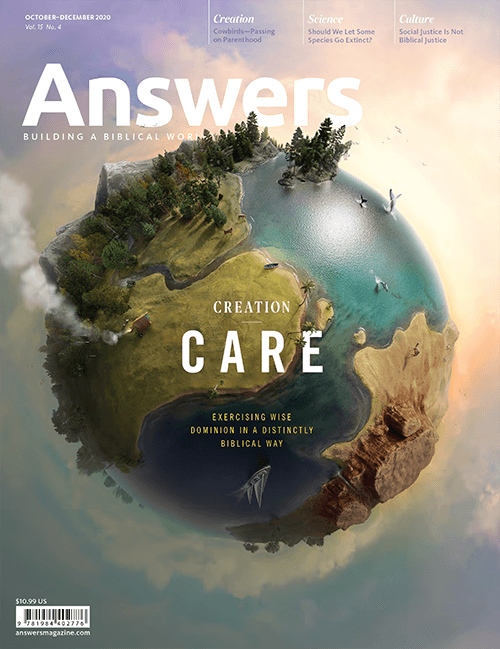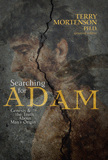
Ape-Men: The Grand Illusion
Now Streaming: Highlights from Answers.tv
Our conversation with Dr. Terry Mortenson
Answers in Genesis offers hundreds of resources that give biblical answers to apologetics questions. In the video Ape-men: The Grand Illusion, AiG speaker Dr. Terry Mortenson discusses how the idea of ape-men attacks a literal, historical Adam and, ultimately, the authority of the gospel. After viewing his video on Answers.tv, we chatted with Dr. Mortenson about why a historical Adam is essential to the gospel.
This presentation covers a topic that is quite controversial in the church. When did Christians start questioning if Adam is historical?
As liberal theology developed in the eighteenth century, some people began to question the historicity of everything in Genesis 1–11, including Adam. But among conservative Christians who believed the gospel, it wasn’t until after Charles Darwin’s book The Descent of Man was published in 1871 that they began to question a historical Adam.
Do you face the most opposition from non-Christians or Christians on this topic?
Personally, I’m not a big target of opposition. Most of my critics are professing Christians, even evangelicals. When I have spoken in secular universities in many different countries, non-Christians have generally been very respectful in raising questions and objections. The most aggressive attack I received was by a professing Christian in a church meeting in England.
Why do you think some Christians don’t believe in a literal Adam?
First, they trust the claims of the scientific majority that genetics and paleontology overwhelmingly prove that humans evolved from an apelike creature over millions of years. Second, they don’t look carefully at and submit to the authority of Old and New Testament statements related to Adam.
What are the implications for the church’s viewing Adam as a figurative character?
Simply put, if Adam and his fall are not literal history, then Jesus died for a mythological problem.
Simply put, if Adam and his fall in sin are not literal history, then Jesus died for a mythological problem, and he is a mythological savior offering us a mythological promise of eternal life. The truth of the gospel stands or falls on the basis of what we do with Adam.
You’ve traveled extensively in your speaking career. How widespread is the belief in a figurative Adam in the church worldwide?
It varies from country to country, depending on the influence of liberal theology. But the churches I speak in are evangelical, and most of them are quite conservative. So they believe in a literal Adam and fall. But most would not know how to defend the truth of Genesis about Adam, and many have compromised with the idea of millions of years. Also, there is a growing influence of theistic evolution (including a denial of Adam) in evangelical circles in countries where I have been in Europe, the Middle East, and Asia.
Are some countries more invested in this belief than others? If so, why?
Where liberal theology and secular academia dominate, professing Christians often doubt or deny the literal history of Genesis 1–11 and accept millions of years and evolution. On the other hand, because of long-term persecution in past or present communist countries and in predominantly Muslim, Hindu, Buddhist, Roman Catholic, or Eastern Orthodox countries, Christians generally believe Genesis 1–11. (After all, who would suffer for what they don’t believe is true?) But I have found that most Christians in those countries have little to no understanding of how to biblically and scientifically defend their beliefs, including in a literal Adam.
What are the best arguments that you can give our readers for a literal Adam?
Like other historical narratives in the Old Testament (such as Genesis 6–50, Exodus, Numbers, Joshua, and Judges), Genesis 1–5 has the characteristics of literal history, not poetry, prophetic vision, or parable, and certainly not myth or allegory. Jesus, Old Testament authors, and the apostles took Genesis 1–11 as literal history, using its details about Adam and Eve to teach about marriage (Mark 10:6; 1 Corinthians 11:8–9), deception (2 Corinthians 11:3; 1 Timothy 2:14), and most importantly, sin, death, and the gospel (Romans 5:12–18; 1 Corinthians 15:21–22, 45).
Genesis clearly says that death came into the world as a result of God’s curse on the whole creation after Adam and Eve sinned (Genesis 3:14–19 and 5:29; Romans 5:12 and 8:18–25). There could not have been millions of years of animal death, disease, and extinction—along with hurricanes, volcanoes, tornadoes, earthquakes, and other natural evils—before the creation of humans, as evolutionists dogmatically claim.
Genesis 2:7 clearly says that God made Adam from the dust of the ground, breathed into him the breath of life, and then he became a “living creature” (or “living soul” as the King James Version says). The variously translated Hebrew words at the end of Genesis 2:7 are nephesh chayyah (נפש חיה). Nephesh is translated as “being,” “creature,” or “soul,” depending on context or translator decision. Chayyah is the adjective form of the verb “to live.” As most English translations show, those same two Hebrew words are translated as “living creature” (or similar) to describe sea creatures, flying creatures, and land creatures in Genesis 1:20–21 and 1:24, Genesis 2:19, and Genesis 9:10. God did not take an existing living creature and transform it into Adam. Genesis 2:7 clearly says that God made Adam, and he became a living creature.
Learn more when you stream Ape-men: The Grand Illusion on Answers.tv. You can also purchase the DVD at AnswersBookstore.com.
Answers Magazine
October–December 2020
When it comes to creation care, Christians have a deeper calling than secular environmentalists.
Browse IssueRecommended Resources

Answers in Genesis is an apologetics ministry, dedicated to helping Christians defend their faith and proclaim the good news of Jesus Christ.
- Customer Service 800.778.3390
- Available Monday–Friday | 9 AM–5 PM ET
- © 2025 Answers in Genesis



